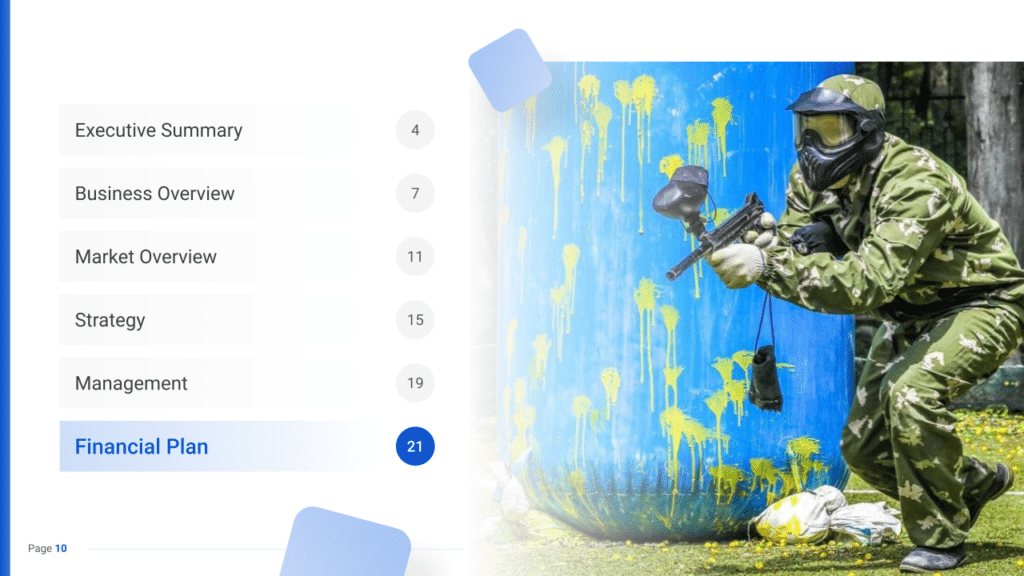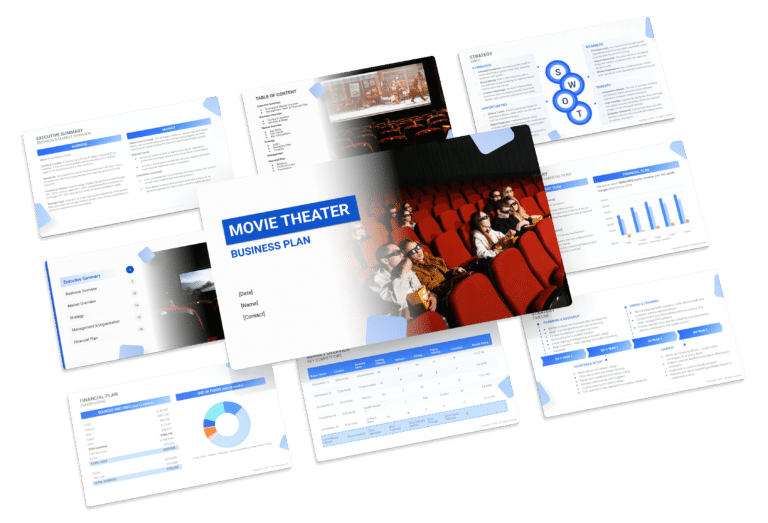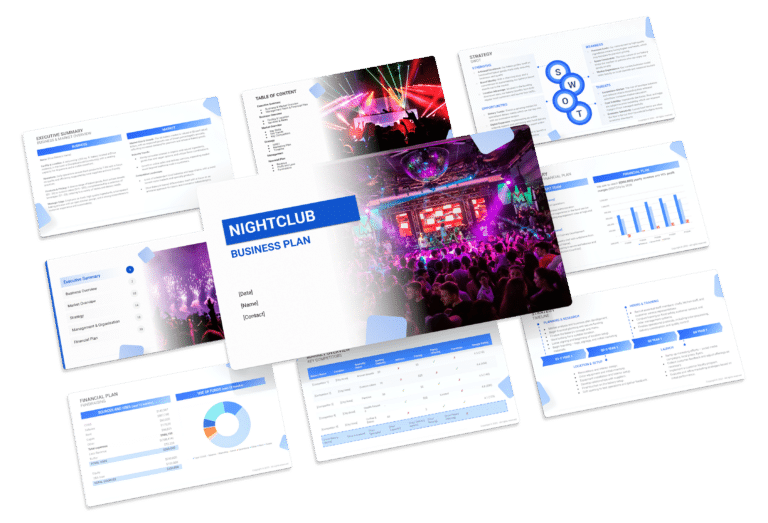Paintball Business Plan Template & PDF Example

Creating a comprehensive business plan is crucial for launching and running a successful paintball business. This plan serves as your roadmap, detailing your vision, operational strategies, and financial plan. It helps establish your paintball business’s identity, navigate the competitive market, and secure funding for growth.
This article not only breaks down the critical components of a paintball business plan, but also provides an example of a business plan to help you craft your own.
Whether you’re an experienced entrepreneur or new to the healthcare industry, this guide, complete with a business plan example, lays the groundwork for turning your paintball business concept into reality. Let’s dive in!
The Plan
Our paintball business plan is structured to cover all essential aspects needed for a comprehensive strategy. It outlines the center’s operations, marketing strategy, market environment, competitors, management team, and financial forecasts.
- Executive Summary:Offers an overview of your paintball center’s business concept, market analysis, management, and financial strategy.
- Business Overview:Provides detailed information on what your paintball center offers and its operational model:
- Facility & Location: Describes the paintball center’s design, amenities, and why its location is appealing to potential clients.
- Services & Rates: Lists the services provided by your paintball center, including game types, equipment rentals, and pricing structure.
- Market Overview:Examines the paintball industry landscape, identifying competitors and how your center stands out:
- Key Stats: Shares industry size, growth trends, and relevant statistics for the paintball market.
- Key Trends: Highlights recent trends affecting the paintball sector.
- Key Competitors: Analyzes main competitors nearby and how your center differs from them.
- Strategy: Outlines how the paintball center intends to achieve growth and attract clients:
- SWOT Analysis: Strengths, weaknesses, opportunities, and threats analysis.
- Marketing Plan: Strategies for attracting and retaining customers.
- Timeline: Key milestones and objectives from start-up through the first year of operation.
- Management: Information on who manages the paintball center and their roles.
- Financial Plan: Projects the center’s 5-year financial performance, including revenue, profits, and expected expenses.
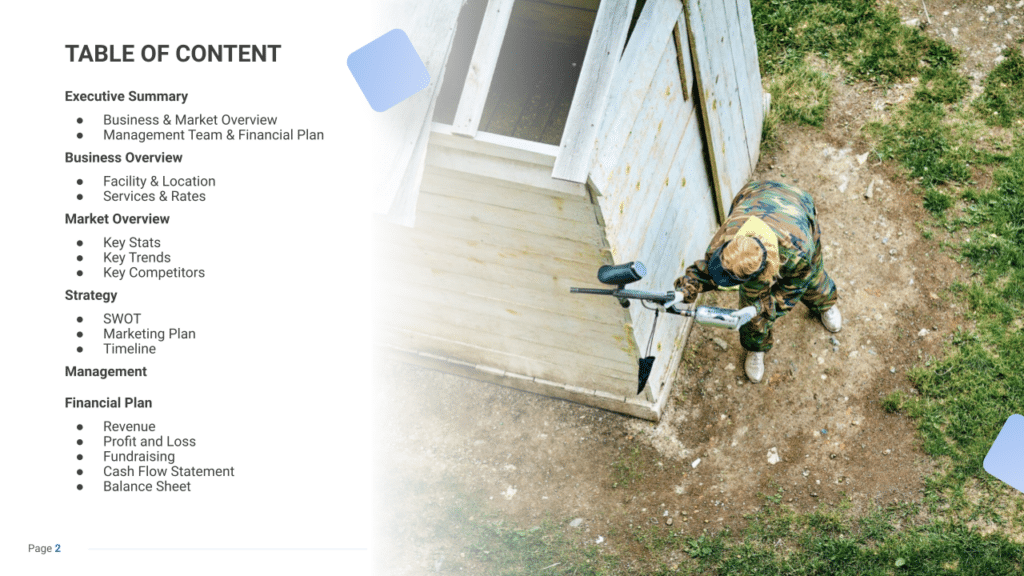
Executive Summary
The Executive Summary introduces your paintball business’s plan, offering a concise overview of your facility and its services. It should detail your market positioning, the range of paintball experiences and events you offer, its location, size, and an outline of day-to-day operations.
This section should also explore how your paintball business will integrate into the local market, including the number of direct competitors within the area, identifying who they are, along with your unique selling points that differentiate you from these competitors.
Furthermore, you should include information about the management and co-founding team, detailing their roles and contributions to the business’s success. Additionally, a summary of your financial projections, including revenue and profits over the next five years, should be presented here to provide a clear picture of your paintball business’s financial plan.
Paintball Business Plan Executive Summary Example
Business Overview
For a Paintball business, the Business Overview section can be concisely divided into 2 main slides:
Facilities & Location
Briefly describe the paintball facility’s physical environment, emphasizing its design, safety features, and the overall atmosphere that excites and welcomes players. Mention the facility’s location, highlighting its accessibility and the convenience it offers to customers, such as proximity to recreational areas or ease of parking. Explain why this location is advantageous in attracting your target clientele.
Services & Rates
Detail the range of paintball experiences and services offered, from basic game packages to specialized events like tournaments, corporate team-building exercises, or themed scenario games. Outline your pricing strategy, ensuring it reflects the quality of services provided and matches the market you’re targeting. Highlight any packages, group discounts, or membership deals that provide added value to your customers, encouraging repeat visits and customer loyalty.
Market Overview
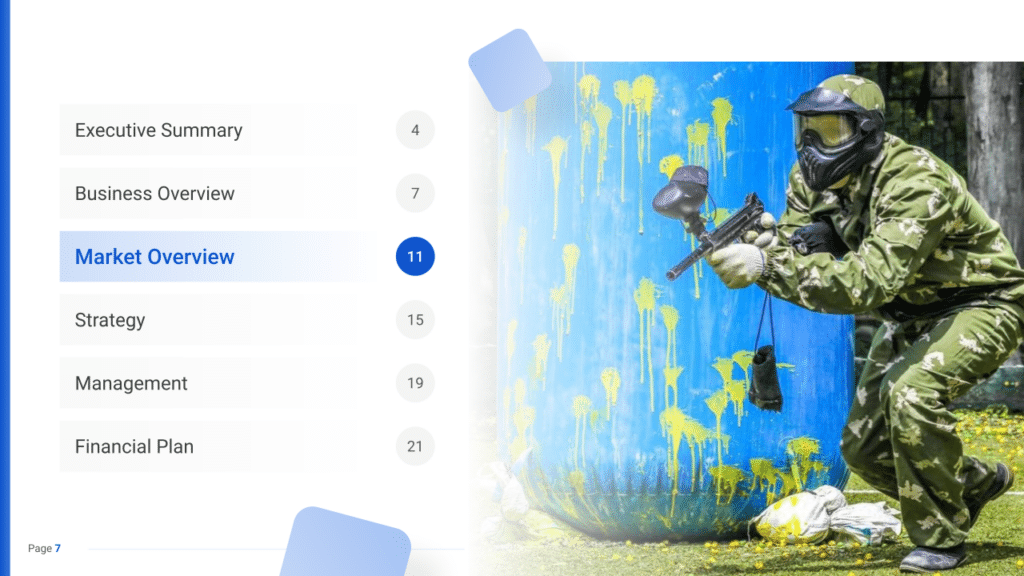
Industry Size & Growth
In the Market Overview of your paintball business plan, start by examining the size of the paintball industry and its growth potential. This analysis is crucial for understanding the market’s scope and identifying expansion opportunities.
Key Market Trends
Proceed to discuss recent market trends, such as the increasing consumer interest in outdoor recreational activities, team-building events, and adventure sports. Highlight the demand for immersive and themed paintball experiences, as well as the growing popularity of paintball as a corporate team-building activity and a popular choice for parties and special events.
Competitive Landscape
A competitive analysis is not just a tool for gauging the position of your paintball business in the market and its key competitors; it’s also a fundamental component of your business plan.
This analysis helps in identifying your paintball business’s unique selling points, essential for differentiating your business in a competitive market.
In addition, the competitive analysis is integral in laying a solid foundation for your business plan. By examining various operational aspects of your competitors, you gain valuable information that ensures your business plan is robust, informed, and tailored to succeed in the current market environment.
Identifying Your Competitors in the Paintball Industry
Begin by identifying both your direct and indirect competitors. This includes other paintball fields, laser tag arenas, and outdoor adventure parks that cater to a similar audience. For instance, if your business specializes in realistic military simulation paintball games, your direct competitors include other venues that offer tactical paintball experiences. Consider indirect competitors such as video game arcades or any activity centers that might attract people interested in team-based competitive activities.
Utilize tools like Google Maps to visualize the geographical spread of these competitors. Customer review platforms like Yelp and TripAdvisor can offer customer reviews and ratings, providing insights into competitors’ strengths and weaknesses. For example, if many reviews highlight a competitor’s well-maintained equipment and diverse game scenarios, these are notable strengths.
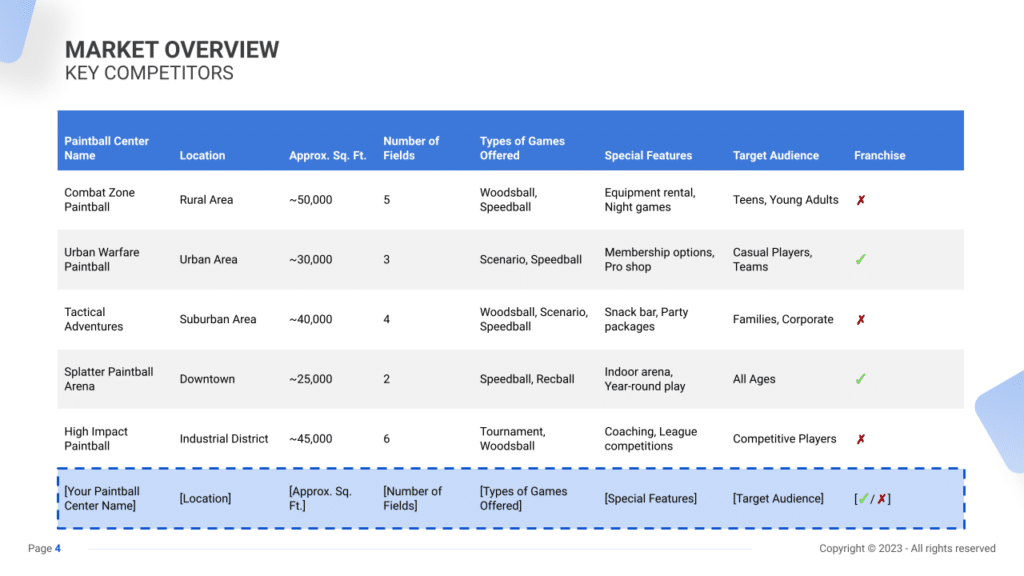
Paintball Business Competitors’ Strategies
Analyzing the strategies of these competitors involves looking at several areas:
- Game Formats and Scenarios: Examine the variety of game formats and scenarios provided. If “Action Paintball Park” nearby is known for its zombie apocalypse night games, this might suggest a consumer interest in themed paintball events.
- Equipment and Safety: Consider the quality of equipment and safety measures in place. A competitor like “Elite Combat Zone” that offers top-of-the-line safety gear and high-quality paintball guns might appeal to a more safety-conscious clientele.
- Pricing Strategy: Review how your prices compare with those of your competitors. Are your session fees similar to those at “Budget Battlefields,” or are they aligned with the more premium experiences offered at “Tactical Adventures”?
- Marketing Tactics: Assess how competitors promote their businesses. Do they rely on social media campaigns, local advertising, or partnerships with schools and corporate groups?
- Customer Experience: Evaluate the overall customer experience. For instance, “FunShoot Arena” may be popular for its friendly staff and excellent customer service, enhancing its appeal.
- Operational Efficiency: Check if competitors use technology or innovative processes to streamline booking, registration, and equipment handling, such as “Streamline Paintball” with its online booking system.
What’s Your Paintball Business’s Value Proposition?
Reflect on what makes your paintball business unique. Perhaps it is known for its extensive and creatively designed playing fields, or maybe it offers exclusive night games that aren’t available elsewhere.
Identify market opportunities through customer feedback and industry trends. For example, the increasing interest in immersive and physically active experiences could be a significant market opportunity if your competitors focus mainly on traditional paintball games.
Consider your location: A paintball business in a rural area might focus on large-scale, immersive game environments, while one in a more urban area might emphasize accessibility, quick play sessions, and corporate team-building events.
Strategy
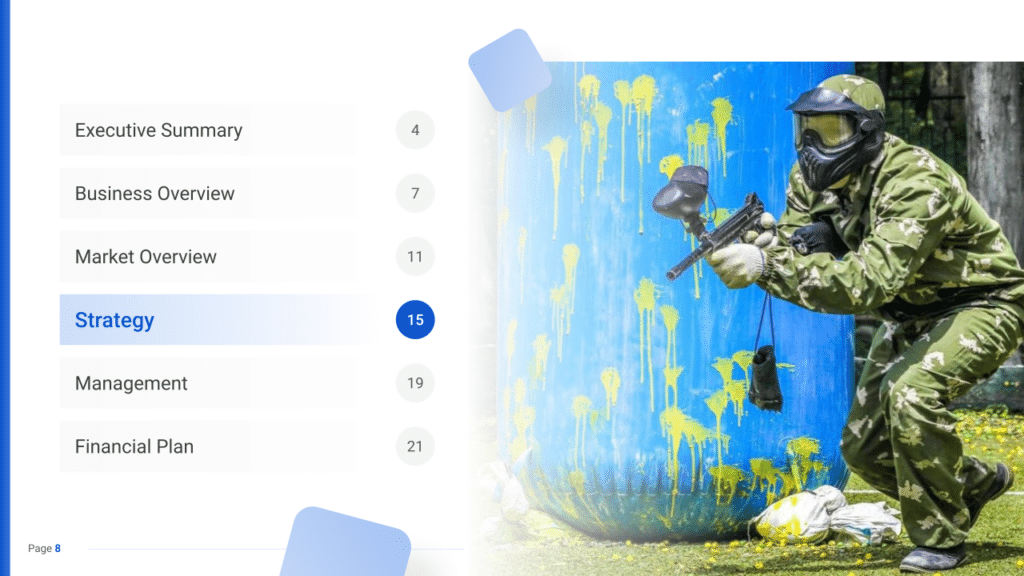
SWOT
First, conduct a SWOT analysis for the paintball business, highlighting Strengths (such as well-designed facilities and engaging game scenarios), Weaknesses (including high operational costs or limited customer awareness), Opportunities (for example, an increasing interest in outdoor recreational activities), and Threats (such as economic downturns that may reduce consumer spending on leisure activities).
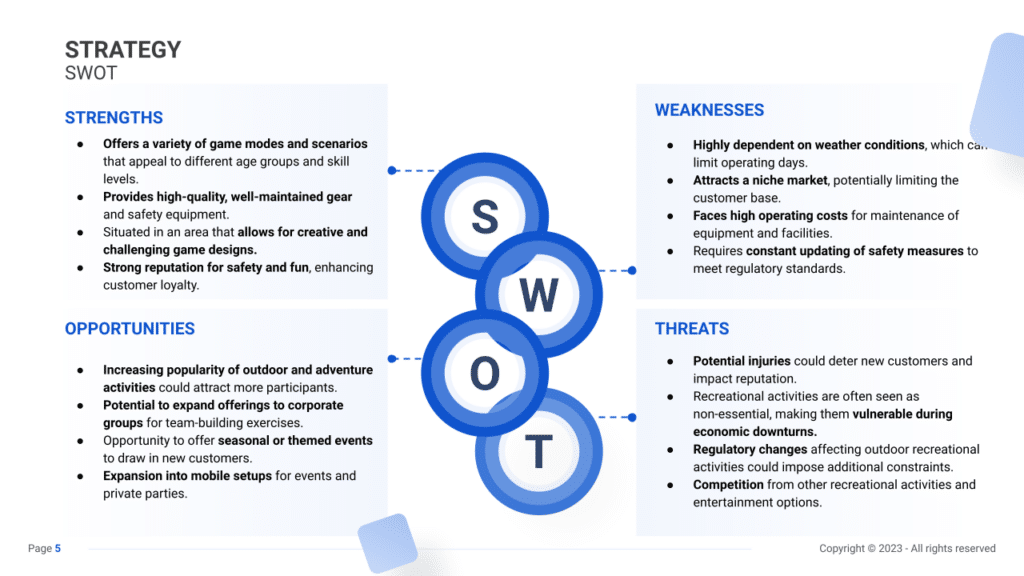
Marketing Plan
Next, develop a marketing strategy that outlines how to attract and retain clients through targeted advertising, promotional discounts, engaging social media presence, and community involvement.
Marketing Channels
Utilize diverse marketing channels to communicate your brand, attract customers, and enhance footfall to your paintball facility.
Digital Marketing
- Social Media Engagement: Utilize platforms like Instagram, TikTok, and YouTube to showcase thrilling gameplay highlights, customer experiences, and promotional offers. Engage actively with followers through comments, direct messages, and interactive content.
- Email Marketing: Build and maintain an engaging email list by offering exclusive discounts, game-day vouchers, or early access to events. Send regular newsletters featuring gameplay tips, event updates, and new equipment releases to keep subscribers engaged.
- Website Development and SEO: Maintain an informative and user-friendly website featuring comprehensive details about field layouts, pricing, customer testimonials, and a blog section providing paintball strategies and tips. Optimize your website for local SEO to enhance visibility within your region.
Local Advertising
- Flyers and Local Print: Distribute eye-catching flyers and posters in recreational centers, gyms, schools, community boards, and popular hangout spots. Advertise in local event bulletins or sports magazines to reach a wider audience.
- Community Engagement: Host introductory sessions, demo days, or tournaments for local schools, youth organizations, or corporate team-building events. Sponsor local sports teams or charity events to increase your brand’s visibility and community involvement.
- Partnerships and Collaborations: Forge strategic alliances with event planners, corporate team-building organizers, or outdoor adventure companies to offer joint packages, exclusive events, or group discounts, expanding your customer base.
Promotional Activities
Attract potential players with compelling offers and exciting events:
- Special Events and Themed Days: Organize themed events like ‘Nighttime Zombie Shootouts,’ ‘Holiday Specials,’ or ‘Corporate Team Building Days.’ Offer discounted group rates or exclusive game packages to entice different customer segments.
- Referral Programs: Encourage existing players to bring in new participants by offering incentives such as discounted rates, bonus game passes, or exclusive access to themed fields.
- Loyalty Rewards and Incentives: Implement a tiered loyalty program where frequent players earn points or rewards for every visit or purchase. Offer exclusive perks such as free gameplay sessions, merchandise discounts, or VIP field access for loyal customers.
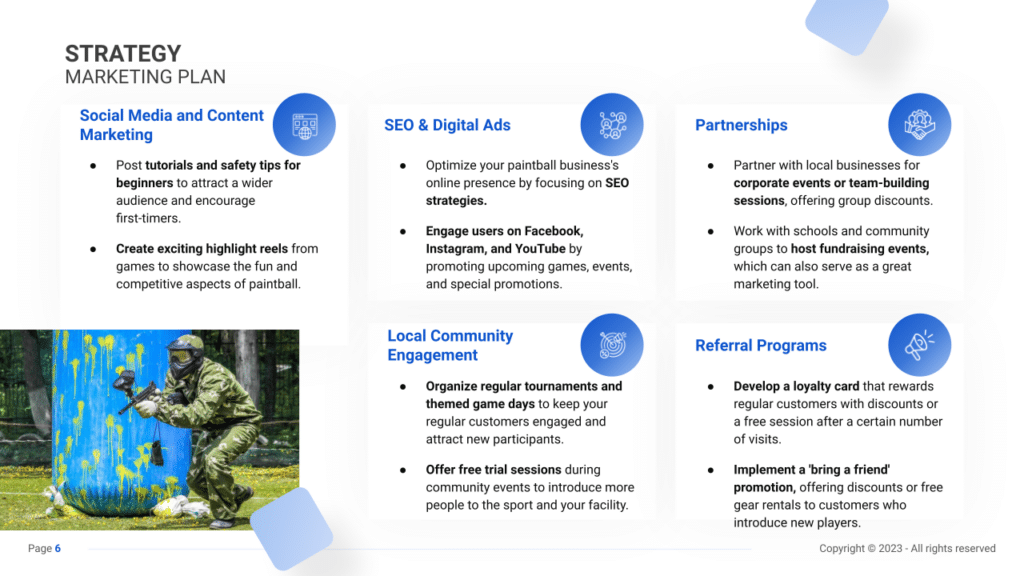
Sales Channels
Efficient sales channels are crucial for maximizing revenue and ensuring customer satisfaction.
In-Person Sales Techniques
Maximize revenue during player visits:
- Equipment Upgrades and Add-ons: Offer players upgrade options such as premium paintball guns, protective gear rentals, themed costume sets, or special ammunition types for an enhanced gaming experience.
- Concession Sales: Create a well-stocked concession stand selling snacks, refreshments, branded merchandise, and paintball gear for players and spectators.
- Package Deals and Group Offers: Design bundled packages for groups, parties, or corporate events, including equipment rentals, gameplay sessions, and catering options, to attract large bookings and boost revenue.
Online Sales and Booking
- Online Booking System: Implement an intuitive and user-friendly online booking system on your website and social media platforms. Offer incentives like discounted rates or exclusive gameplay options for online bookings.
- E-Commerce Store: Set up an online store featuring branded merchandise, paintball gear, gift vouchers, and exclusive online-only packages. Provide special offers and limited-time discounts to drive sales and attract online customers.
- Virtual Consultations and Booking: Offer online consultations for event planning, personalized gameplay sessions, or equipment rentals. Use virtual meetings to provide recommendations, discuss requirements, and make reservations tailored to customer needs.
Membership and Loyalty Programs
Encourage repeat business and foster long-term relationships:
- Membership Packages: Create diverse membership plans offering regular gameplay at discounted rates, access to exclusive fields or events, or additional perks for loyal members, encouraging them to commit to your business.
- Loyalty Benefits and Rewards: Develop a robust digital loyalty program where players earn points or rewards for every visit, purchase, or referral. Offer redeemable benefits such as free gameplay sessions, merchandise discounts, or VIP event invitations to retain and reward loyal customers.
Strategy Timeline
Finally, create a detailed timeline that outlines critical milestones for the paintball business’s opening, marketing efforts, client base growth, and expansion objectives, ensuring the business moves forward with clear direction and purpose.

Management
The Management section focuses on the paintball business’s management and their direct roles in daily operations and strategic direction. This part is crucial for understanding who is responsible for making key decisions and driving the paintball business toward its financial and operational goals.
For your paintball business plan, list the core team members, their specific responsibilities, and how their expertise supports the business.
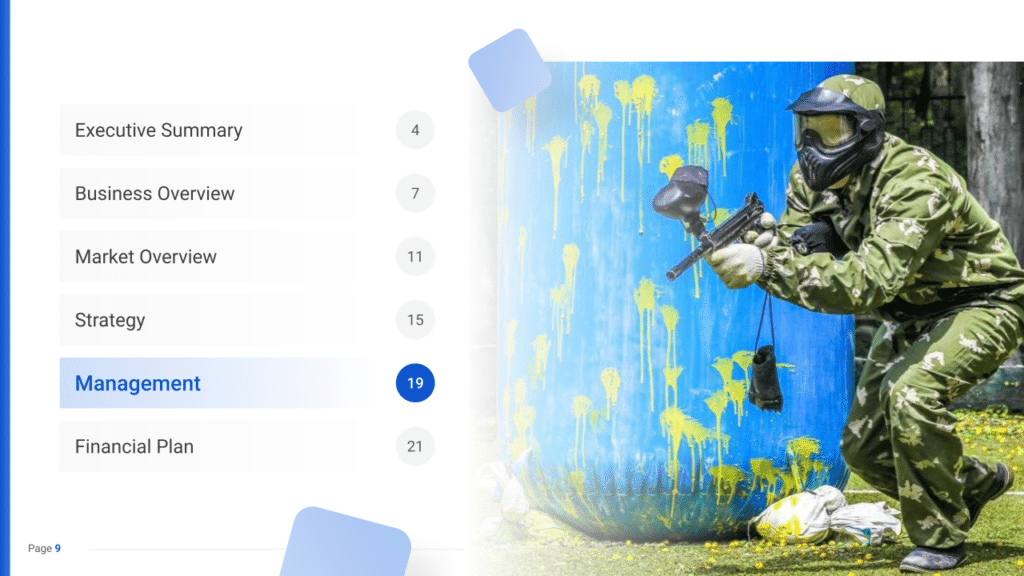

Financial Plan
The Financial Plan section is a comprehensive analysis of your financial projections for revenue, expenses, and profitability. It lays out your paintball business’s approach to securing funding, managing cash flow, and achieving breakeven.
This section typically includes detailed forecasts for the first 5 years of operation, highlighting expected revenue, operating costs, and capital expenditures.
For your paintball business plan, provide a snapshot of your financial statement (profit and loss, balance sheet, cash flow statement), as well as your key assumptions (e.g. number of customers and prices, expenses, etc.).
Make sure to cover here
_ Profit and Loss
_ Cash Flow Statement
_ Balance Sheet
_ Use of Funds
